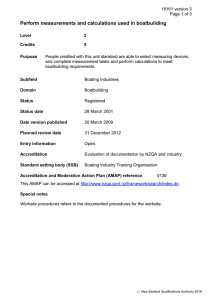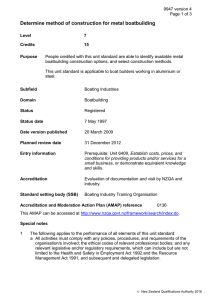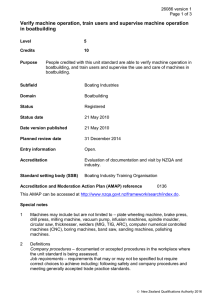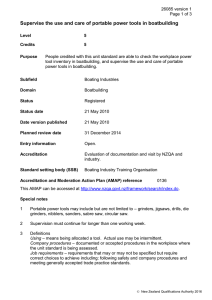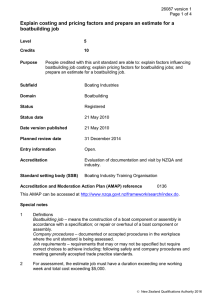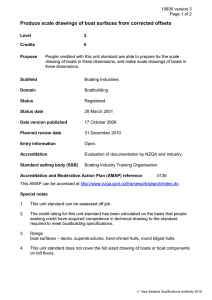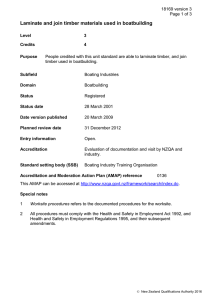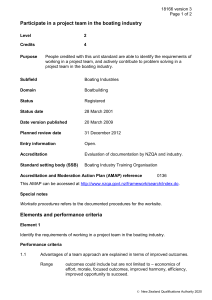Calculate quantities and costs for boatbuilding projects
advertisement
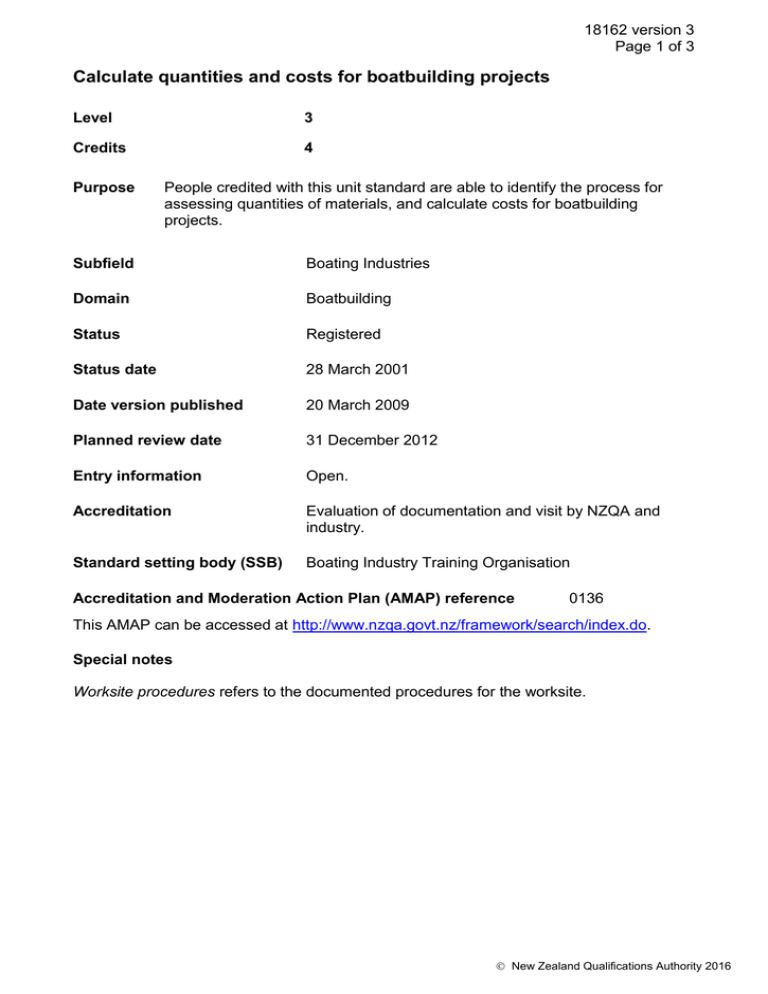
18162 version 3 Page 1 of 3 Calculate quantities and costs for boatbuilding projects Level 3 Credits 4 Purpose People credited with this unit standard are able to identify the process for assessing quantities of materials, and calculate costs for boatbuilding projects. Subfield Boating Industries Domain Boatbuilding Status Registered Status date 28 March 2001 Date version published 20 March 2009 Planned review date 31 December 2012 Entry information Open. Accreditation Evaluation of documentation and visit by NZQA and industry. Standard setting body (SSB) Boating Industry Training Organisation Accreditation and Moderation Action Plan (AMAP) reference 0136 This AMAP can be accessed at http://www.nzqa.govt.nz/framework/search/index.do. Special notes Worksite procedures refers to the documented procedures for the worksite. New Zealand Qualifications Authority 2016 18162 version 3 Page 2 of 3 Elements and performance criteria Element 1 Identify the process for assessing quantities of materials used in boatbuilding. Range materials may include but are not limited to – metals, resins, reinforcements, paints, plywood, lumber, wire, fluids. Performance criteria 1.1 Type of calculation required is identified in terms of area and/or volume of hull form, decks and tank approximations, and materials used. Range 1.2 Boatbuilding terminology is explained in terms of design. Range 1.3 calculations include but are not limited to – mechanical advantage and friction, simple naval architectural calculations (centre of buoyancy, centre of effort), international tonnage measurement (gross registered tonnes), displacement. terminology includes but is not limited to – mechanical advantage and friction, displacement (light, half load, heavy). The process for assessing quantities of materials used in boatbuilding is described in terms of calculating the area, volume, weight and thickness for the required medium. Element 2 Calculate costs for boatbuilding projects. Performance criteria 2.1 Written scope includes materials required to meet project requirements. 2.2 All resources required are listed clearly and accurately. Range 2.3 resources may include but are not limited to – metals, resins, reinforcements, paints, plywood, lumber, wire, fluids, labour; evidence of two boatbuilding projects is required. Terms used in costing are explained in terms of labour costs and material costs. Range labour costs include but are not limited to – direct payroll cost, overhead, margin, charge out rates, subcontract rates; material costs include but are not limited to – fixed price, cost plus, gst, freight, impact of exchange rates on costing. New Zealand Qualifications Authority 2016 18162 version 3 Page 3 of 3 2.4 The impact of changing individual components is described in terms of the effect on project costs. 2.5 Project costs are calculated and documented according to worksite procedures. Please note Providers must be accredited by NZQA, or an inter-institutional body with delegated authority for quality assurance, before they can report credits from assessment against unit standards or deliver courses of study leading to that assessment. Industry Training Organisations must be accredited by NZQA before they can register credits from assessment against unit standards. Accredited providers and Industry Training Organisations assessing against unit standards must engage with the moderation system that applies to those standards. Accreditation requirements and an outline of the moderation system that applies to this standard are outlined in the Accreditation and Moderation Action Plan (AMAP). The AMAP also includes useful information about special requirements for organisations wishing to develop education and training programmes, such as minimum qualifications for tutors and assessors, and special resource requirements. Comments on this unit standard Please contact the Boating Industry Training Organisation training@bia.org.nz if you wish to suggest changes to the content of this unit standard. New Zealand Qualifications Authority 2016
